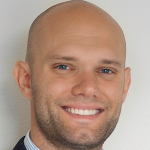Henry Abbott is an award-winning journalist and the founder of TrueHoop. He led ESPN’s 60-person NBA digital and print team, which published several groundbreaking articles and won a National Magazine Award.
What’s the big idea?
Imagine a few dogs frolicking on the beach, just romping through the waves and bounding upon the sand. The goal of Ballistic is for you to be able to have that much fun moving your human body. The most cutting-edge research regarding athletic injuries is finding that we have been blind to some of the most critical prevention measures.
Below, Henry shares five key insights from his new book, Ballistic: The New Science of Injury-Free Athletic Performance. Listen to the audio version—read by Henry himself—in the Next Big Idea App.
1. Prevention is key.
Marcus Elliot had a life quest: he hoped to play college football. But when, on his 17th birthday, he tore his ACL at football practice, he had to spend six months being depressed in his bedroom instead. The injury had upended all his dreams.
He emerged from that setback with a new life quest: he would study the human body so that he might one day be able to prevent the injuries that ruin sports. His journey took him to the University of California, Santa Barbara, where he studied microbiology. Then, he worked as a lifeguard and professional triathlete for a while before attending Harvard Medical School. He studied everything he could, from infectious diseases to delivering babies, and eventually he studied with an elite physiologist, Tim Noakes, in South Africa. Then he worked for the New England Patriots, focusing on preventing hamstring injuries, followed by the Seattle Mariners, the U.S. Olympic Training Center, and with elite Canadian sprinters and cyclists.
It became clear to him that there wasn’t an obvious field that contained the clues to injury prevention. Is the answer in microbiology? Physiology? Neuroscience? Athletic training? He had many years of many signs that hinted at where injuries were coming from, but no reliable way to identify those origins.
2. Movement contains the key dataset.
Many years into his quest, it became clear to Marcus that movement is the dataset containing key clues to injury prevention. He installed force plates in the floor of his startup movement lab in Santa Barbara, called the P3 Peak Performance Project, and later installed infrared cameras in the ceiling to enable full-motion capture. It was good news that he pinpointed the field where clues to future injuries lie, but the bad news is that this particular field is very complex. As famous neurologist Oliver Sacks said, “Much more of the brain is devoted to movement than to language. Language is only a little thing sitting on top of this huge ocean of movement.” Marcus was delving headlong into this ocean.
“Robots can’t run at all over lumpy terrain because it takes too much processing power.”
A study found that humans can run almost the same speed over lumpy terrain as over flat terrain. Meanwhile, robots can’t run at all over lumpy terrain because it takes too much processing power. Our brains are this giant neuro-processor that is very attuned to moving us through space in brilliant ways. Marcus was proposing that he would decode that in the way that, for instance, the conductor of an orchestra might say it sounds like a violin is a bit flat, making the orchestra sound bad. He wanted to wade into the 600 muscles of the human body and the symphonic ways that they move and identify issues.
3. Most athletic injuries come from landing.
In physics class, you may have conducted an experiment where you receive an egg, some pipe cleaners, plastic bags, duct tape, balloons, and a few other items. Your task is to create a contraption that allows the teacher to stand on a ladder or lean out the window and drop this raw chicken egg so that it does not shatter upon landing.
Now, think about your own human body. We are that egg. About 80 percent of our mass is in the torso, and the contraption that we have for landing safely are the three stacked joints of our ankles, knees, and hips. They’re fantastic at attenuating the force of landing so that our egg does not drop.
Our landing contraption has to be fantastic because the biggest forces involved in human movement come from landing. We might think it comes from lifting heavy weights or jumping, but it’s gravity that pulls us down. In Marcus’s lab, an NBA player stepped off an 18-inch-tall box and landed on the force plates with 11,000 Newtons of force. To put that in context, the punch of a pro boxer is about 100 Newtons of force. More importantly, they isolated that it takes about 2,800 Newtons of force to fully sever a human spine. So, there was an NBA player who landed with more than triple the force necessary to fully sever his spine, which means he has legs that are good to land on. The force of free fall is immense and more than enough to injure us.
4. Knee injuries don’t happen in the knee.
Marcus built what is still one of the world’s leading movement labs. More than 70 percent of the NBA’s roster players have visited P3 in Santa Barbara and been assessed. Their servers have 134.4 terabytes of movement data from elite athletes from all major sports, including soccer, tennis, track and field, baseball, football, and even NASCAR.
His lab’s corpus of knowledge has become so big that P3 has been able to extract cause-and-effect lessons. If a professional athlete tears their ACL, then the people at P3 can review their database to see how that person moves and look for clues. They’ve been building this for more than a decade now, utilizing motion capture data (which contains nearly a million data points per assessment, per athlete) and force plate data.
“It is a dangerous habit to land on the outside of your foot and then have the force of landing roll to the inside.”
This is perhaps the most valuable database in the world because it includes a whole new set of keys to understanding what causes human injuries. One of their studies is of almost 400 NBA players, tracked over years, to see what movement habits were present in players who had catastrophic knee injuries, which most commonly are ACL tears. Academic literature has long explored aspects such as the width of the ligament itself, a movement known as valgus collapse in which the knee caves inward, or hormonal factors, but P3’s granular movement dataset contributed a whole new perspective.
The number one leading factor for knee injury, according to P3’s results, has to do with how a foot lands on the ground. Over time, it is a dangerous habit to land on the outside of your foot and then have the force of landing roll to the inside. A little bit of that is quite common, but as your ankle rolls in this way, your shin moves like a windshield wiper from one side to the other. If it moves 25 degrees or more, then it becomes a giant indicator of knee injury risk.
The second factor they have identified is in the hip, specifically when people land. Many people can have their hip sink down, which is good, but some people have the femur (upper leg bone) rotate within the leg as you squat down. The effect of that is a little bit like twisting the drumstick off a turkey. It’s hard to identify with the naked eye, but with the motion capture system, it’s evident and a major red flag. If your femur rotates as you land, this is something that needs to be addressed immediately.
The third leading cause is also in the hips, and it’s effectively how good the muscles of your hips are at decelerating you. If your hips, knees, and ankles are bending together as you land, you can absorb a lot of force into your hips, and if you’re good at absorbing that force, then you’re going to land more safely.
“If your femur rotates as you land, this is something that needs to be addressed immediately.”
All these things can be improved with training. As Oliver Sacks pointed out, the language component of our brain sits on top of the movement component. They work synchronously and similarly, and so just as you can learn more vocabulary or learn a little Spanish or French, you can also learn to move your hips a little differently or to land with a strong ankle position that doesn’t roll from side to side.
The various existing assessments, like x-rays and MRIs, in many cases completely miss the source of the catastrophic knee injury. Derek Rose was the reigning MVP of the NBA when he tore his ACL. If you’d done an MRI of his knee the morning he tore it, it quite probably would’ve looked perfect because it wasn’t injured by the ligament. It was injured by things that happened in his hip above or foot below. This is the pattern. This research promises better healthcare because it reveals that we’ve been blind to the true causes of many of the most significant sports injuries.
5. Our hips need help.
Everybody they’ve ever seen at P3 either needs to work on their hip mobility or hip stability. In a sort of joking way, they say that everybody who goes to yoga should lift weights, and everybody who lifts weights should go to yoga.
You want your hips to be both mobile and stable, but the trend is that most of us focus on only one of these aspects. In Ballistic, there is a handy diagram of a home assessment you can do if you think you have hips that need work on mobility or stability. Everybody should be working on addressing both.
Enjoy our full library of Book Bites—read by the authors!—in the Next Big Idea App:










